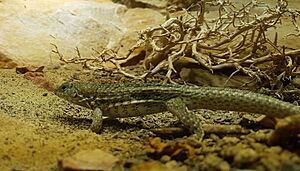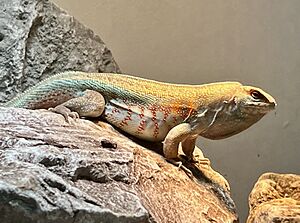Hispaniolan curlytail lizard facts for kids
Quick facts for kids Hispaniolan curlytail lizard |
|
|---|---|
 |
|
| In captivity | |
| Conservation status | |
| Scientific classification | |
| Genus: |
Leiocephalus
|
| Species: |
schreibersii
|
| Synonyms | |
|
|
The Hispaniolan curlytail lizard (Leiocephalus schreibersii) is a common and interesting lizard. It's also known by names like the Hispaniolan khaki curlytail or the red-sided curlytail lizard. These lizards belong to the family Leiocephalidae. They are native to the island of Hispaniola in the Caribbean, which includes both Haiti and the Dominican Republic. You can also find them in southern Florida, where they were introduced.
Contents
About the Hispaniolan Curlytail Lizard
What's in a Name?
The scientific name for this lizard is Leiocephalus schreibersii. The second part of its name, schreibersii, honors an Austrian naturalist named Carl Franz Anton Ritter von Schreibers. This is a common way for scientists to name new species.
There are actually two recognized types, or subspecies, of the Hispaniolan curlytail lizard. These are slightly different versions of the same species.
Where Do They Live?
The Hispaniolan curlytail lizard naturally lives on the main island of Hispaniola. This island is shared by the Dominican Republic and Haiti. They also live on a smaller island nearby called Île de la Tortue.
These lizards prefer to live in shrubland areas. This means places with lots of bushes and small trees. They can be found from sea level up to about 500 m (1,600 ft) high. They also live in Florida as an introduced species.
Life Cycle and Behavior
The Hispaniolan curlytail lizard is active during the day. This means they are diurnal animals. They spend their daylight hours moving around and looking for food.
These lizards mainly eat insects. They are good at catching small bugs to fill their diet.
When it comes to reproduction, these lizards are oviparous. This means the female lizard lays eggs. The young lizards then hatch from these eggs.



